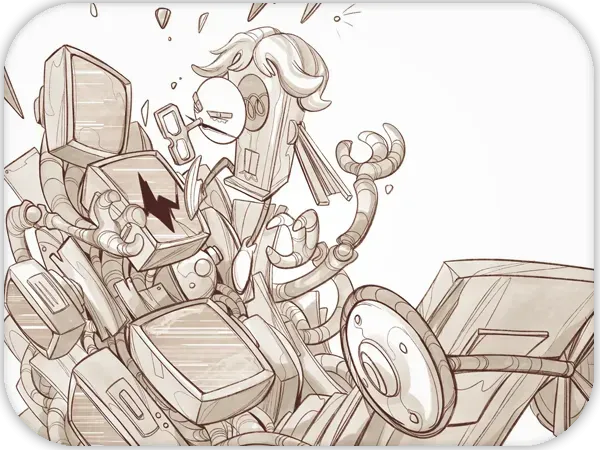Justa Diva
She sings like a legend, shines like a queen,
and vanishes like a rumor.
She is more than a spectacle –
but not quite what she seems.

Justa Diva is the first anthropomorphic plant in the Forest – an eccentric, tragicomic figure with the soul of an opera singer and a body rooted in a flowerpot. She appears as if from nowhere, steeped in melodrama. At first, she seems superficial – a fading star obsessed with her former glory. But Anne sees beneath the surface – and gives her a new role.
The Elves, brilliant musicians, dream of their first concert – but lack a voice. Diva becomes the missing link. Thanks to Anne’s persistence, she joins the band and rises out of despair. For a moment, they shine together.
But Justa Diva is not a one-sided character. That’s why she belongs to the category of “In-Betweens” – beings who are neither good nor evil. Her vanity, though comedic, has serious consequences. In the second book, she accidentally reveals an important secret that alters the Forest’s fate. She doesn’t do it out of malice – but the harm is done.
And yet her path includes redemption. In a pivotal moment, she saves Anne, and her friends welcome her back without reproach. In the third book, she is weak and ill, but the Elves carry her through the desert with care and tenderness.
She is not a hero. Nor a villain. She is a soul with a voice – sometimes too loud, sometimes too late, but never forgotten.
– Flowerpot = beauty and rootedness within limitation
– Color change = emotions as outward appearance
– Voice = identity through expression
– Wilted leaves = lost fame, vulnerability
Sweet child, you’re speaking with a living legend! Try to remember this moment, will you? Many people would pay dearly to be in your place.
Ah! Now that’s what I call a pleasant surprise! Turns out I’m singing for an educated audience. And here I was thinking today’s children only listen to rap or some other modern nonsense the radio spits out.
You are a strange generation. At your age, we were still playing with dolls, and here you are chasing jobs and success… But where does childhood go?
Each of us can work miracles – the hard part is just believing it.
From the outside, I probably look like an aging and occasionally not-so-pleasant lady. But when I start to sing, I can become whatever I want – a young girl, a sorceress, or a witch – simply because I believe in what I sing. That’s the magic.
📘 Book I
– The first anthropomorphic plant in the Forest – a tragicomic operatic figure in a flowerpot
– Appears suddenly, steeped in the melodrama of her own downfall
– Becomes the singer in the Elves’ band – regains her dignity through music
– Briefly achieves harmony with Anne and the Elves
📗 Book II
– Appears as a spectacular figure from Heino’s propaganda
– Steps on stage at the decisive moment, disguised as an icon of lies
– Unexpectedly saves Anne from the spiders, redeeming her betrayal
– Admits it was vanity and weakness, not malice, that led her to yield to Heino
– Symbolizes the replacement of art with commerce and the fear of being forgotten
– The resistance begins with her: her repentance sparks change
📙 Book III
– Does not play an active role
– Her memory remains as a warning: what happens when one chooses glamour over truth
– Her voice and image appear fleetingly as part of the joyful victory
– Some say she was once human, turned into a plant as punishment for forgotten vanity.
– Her voice may carry traces of lost magic — the Elves sense it, but don’t speak of it.
– Was her betrayal truly accidental — or just another role for a new audience?
– The Ghost Ballerina and Diva resemble each other more than it seems — perhaps they tell the same fractured story.
– After the battles, she usually disappears. Some believe she took root in a forgotten stage set — still waiting for applause.


